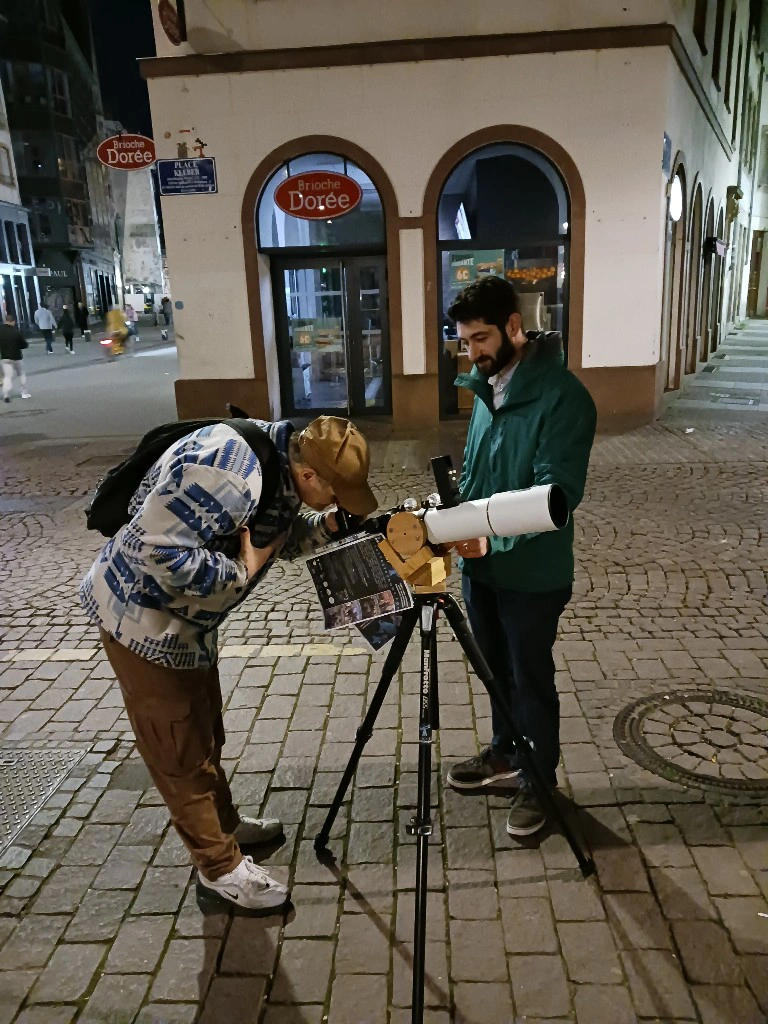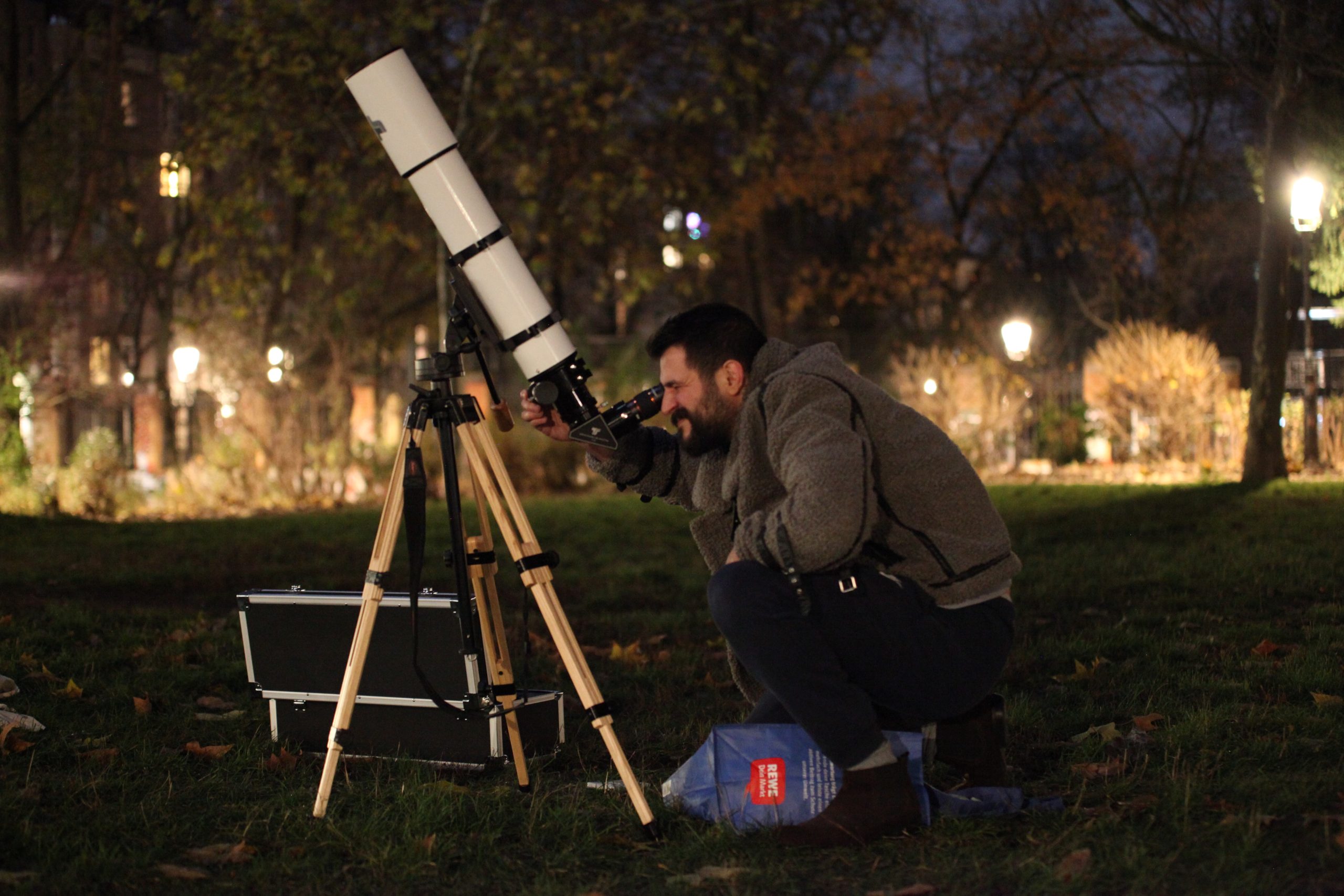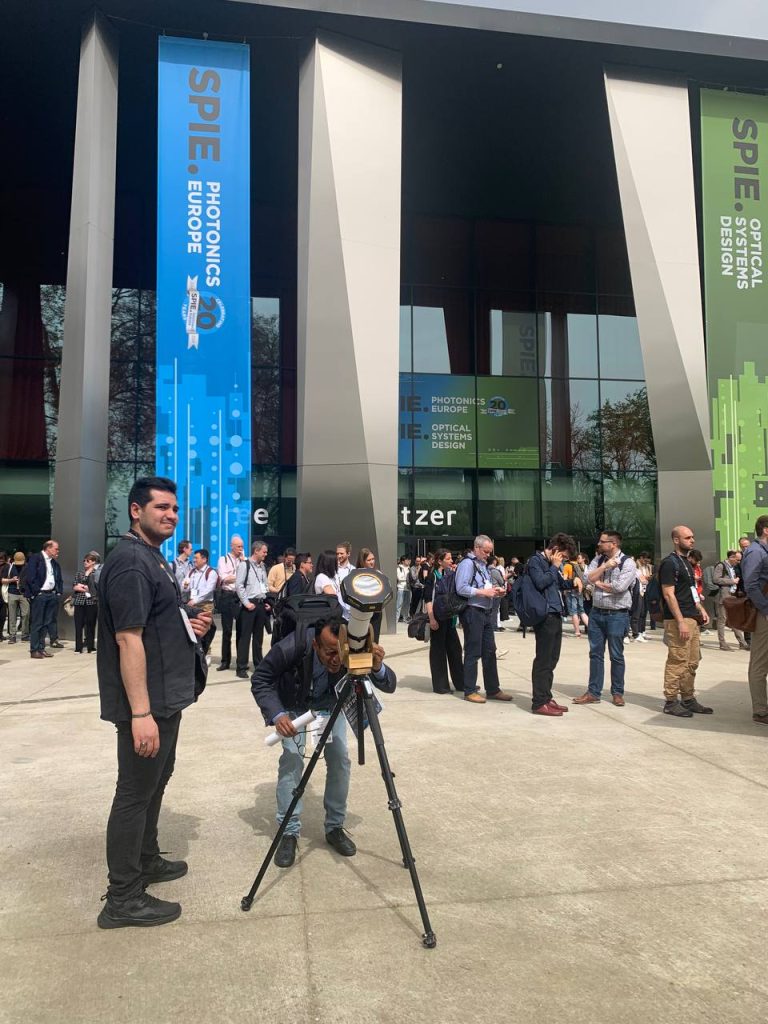
My good friend and mentor, Julius Muschaweck, invited me to see his talk at SPIE Optical Systems Design in Strasbourg. He’s an expert in illumination optics, and he worked at OSRAM when they brought the LED to market. We met when I took his course, after I realized just how hard it is to design optics for illumination.
I booked a hotel room for two, and convinced my friend and fellow street astronomer, Behzad, to join me from Brussels. I packed my telescope, my new dobson mount, three eyepieces, two shirts, and boarded the train.
SPIE is a professional organization for optical engineers. I would meet people who design LEDs, people who build space telescopes, laser scientists, and everyone inbetween. A telescope is 400 year old technology. Surely, spontaneous astronomy isn’t new, interesting, or unique for these people.
The train pulls into the Gare Centrale, I mount my green hiking rucksack onto my back, and roam down narrow, brick laden streets toward our room. Behzad meets me, we share a meal, and take an early night. We expect rain the next day, so I suggest that we take things slow and easy in the morning.
The next day, sunlight pierces through the window. I walk over toward the window and look out over terracotta rooftops. The sky is clear and cloudless. When the sky is clear, I go mad. I nudge Behzad awake, and say the plan has changed.
“Behzad, we can walk over to the conference now, and start making Solar observations in time for the first coffee break.”
I feel bad for waking him. He’s finishing his Masters in Photonics, has a busy job, and often sleeps little to make everything fit together.
“Don’t worry about it. I didn’t come here to rest, I came here to do this with you.”
This makes me smile. I’m inspired by his enthusiasm. Behzad was one of the first people to join me out on the street in Brussels. He showed me that more people could be interested in Street Astronomy, and that all together, we could make a big impact. He’s a big reason why we started the BXLunatics, and tried to form a community around spontaneous astronomy outreach.
We begin our beautiful walk over toward the event center, passing stone bridges, and stopping for an obligatory croissant halfway there. We embrace our the warm spring sun, and our reunion. Life had gotten busy. It was more than a year since we last did this together.
On approach to the conference building, we are greeted by a deep blue glass facade, and sharp modern concrete edges. This attractive venue has a large lawn facing directly south. We pitch our telescope in the center of the square and begin our work.
“Do you want to see a sunspot?”
Our first group comes over.
“Is that safe to look at?”
“Yes! It is! We’ve got a special filter over the lens. Only 0.001% of the light comes through.”
Our first participant looks inside.
“What are those?”
“The sun is a big ball of hydrogen fusion. There’s a strong magnetic field associated with that. Sometimes that field gets tangled into a loop and pops out of the sun. It creates sunspots. They look dark because there’s less radiation there. Only 4000 degrees.”
“I’ve seen this in pictures, but never in real life before!”
“Those black dots are each the size of the Earth.”
He pops up from the eyepiece and looks at me in disbelief.
“Look again at the shape! What does it look like?”
“It’s not circular, it’s more elliptical.”
“Yup! Because the sunspots are caused by magnetic field lines, they always exit the sun and then go back in. They always come in pairs. So one sunspot is a + and another nearby is a -.”
Is this crazy? Inside, experts scientists share their latest innovations. If you want to know what the future looks like, just walk inside. But instead, we’re outside, staring at the sun with 400 year old technology.
10 minutes before noon. The sun hangs directly overhead. Food trucks begin to grill, and their aroma wafts through the glass doors. Lunchhour begins. Large lines form on either side of us. As the scientists await their food, they wonder. What are we looking at? The sun ticks forward in the sky. Waves of scientists crash against our telescope, gathering in an ebb and flow during every coffee break.
Some colleagues from Edmund Optics pass by, including my friend Latifah. I show them what eyepiece I’m using. An Edmund Scientific RKE. It’s like a museum piece!
Two days pass like this in a blink.
On the final day, the sky is finally aligned. The brand new crescent moon hangs overhead. Jupiter is in conjunction with the moon, meaning that they appear close together in the sky in a serendipitous constellation. The only misalignment was our train schedule. I fretted. Should I change my trains to give myself a few more hours, and to pitch this project to a few more scientists? Should I spend all this extra money on new trains?
Behzad told me: “If money is the only thing, do it anyway. Don’t worry about it.”
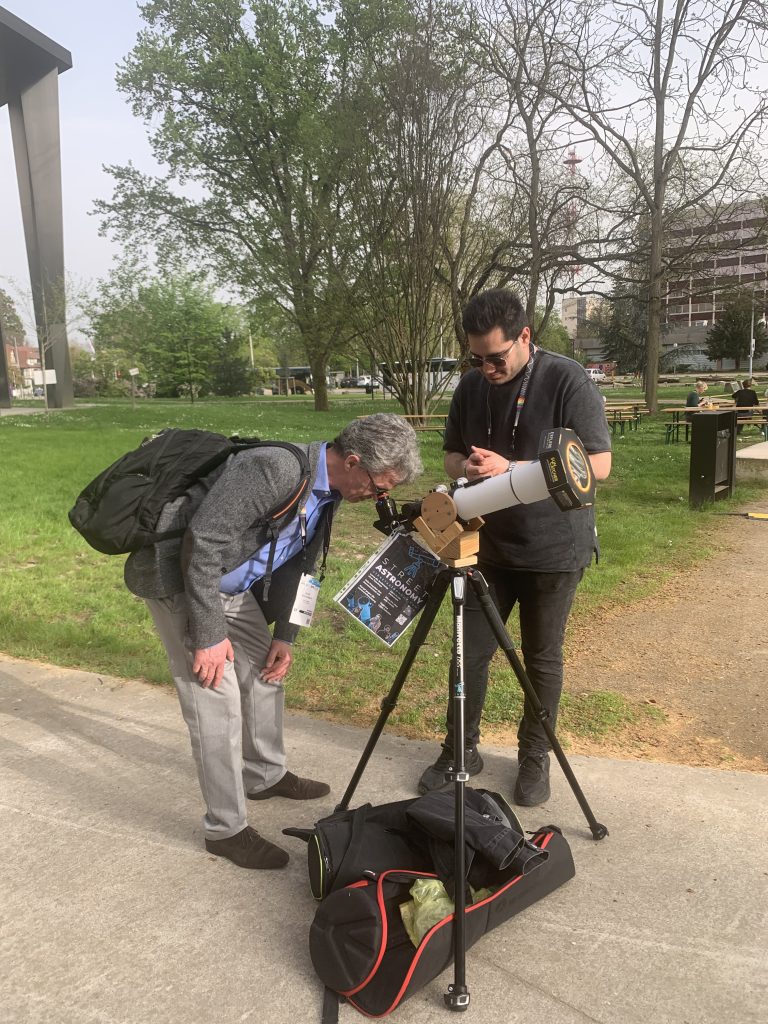
That got me halfway there. But I reflected. This is irrational. We’ve already made a great impression on hundreds of people. It’s already a job well done.
During our final morning of Solar Observations, I share a nice conversation with Behzad. His bus leaves in 45 minutes. Funny. On the first night, it felt like we had so much time to catch up. Now that he’s gathering his things and preparing to leave, I would do anything for 15 more minutes. We say goodbye, and I continue to tend the telescope, now alone.
Julius passed by the telescope on his way into the sessions. He asked me if we could see the moon tonight, and if we would take the telescope into the city to do outreach with the public.
I thought again: what really stressed me out the most about changing my plans? I really didn’t mind traveling in the middle of the night. It was the money that bothered me. But Behzad told me not to worry about this.
“Julius, if you want to join me for street astronomy tonight, I’ll stay”. I told him that he made me feel young again. I booked a 00:30 flixbus to Karlsruhe, a 03:30 train to Frankfurt, and a 04:45 train back to Berlin.
One more time, the sun ticked forward, until the buildings cast long evening shadows, and the crescent moon, without the sun, became the brightest object in the sky.
I stand outside, with a few moments to myself. I sit down on a bench nearby. With time to rest, time to think, I now sense the throbbing of my feet, the lethargy in my body. I am deeply tired. This doesn’t feel comfortable. I stand back up and the feeling subsides.
The sky darkens. The dinner inside the event ends. Julius comes out to meet me. We gather some fellow scientists toward the tram. The telescope imposingly stands atop its tripod, keeping its balance as we swing left and right during a busy hour.
We pop out of the tram at Place Kléber. I’m pleasantly surprised. We’re not out of time. The moon and Jupiter are still above the buildings. A moment later, my old optics professor, Julie Bentley, approaches us. She wants to see what’s in the telescope.
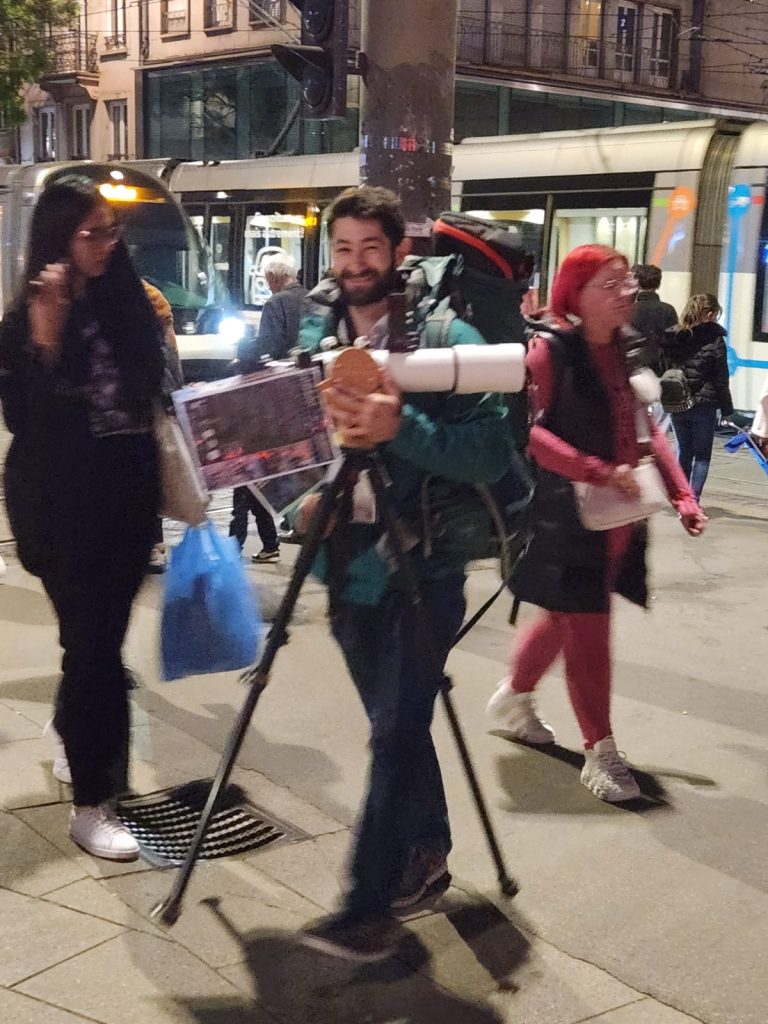
I prepare the eyepiece with seconds to spare. Her tram is already approaching the platform. Center the planet, first with the low power. Change to high power. Refocus. She tells me to hurry! It’s ready. She looks inside. “Yeah! I can see the moons”. The tram door opens. We rush to say goodbye.
Julius and I march toward the square. What follows is a perfect flow of street astronomy. Strasbourg is located in the Alsace region of France, right next to the German border. My conversations are mixed French and German. I can speak like a five year old in French and a 7 year old in German. It’s enough to give people a few interesting facts about the moon.
We are joined by many people from the conference. Thierry Lépine, who recommended this location to us, meets us. They’ve caught the itch for street astronomy! Julius is approaching strangers at random, asking them if they’d like to see the moon. Thierry is taking photos and giving people information about what they’re seeing.
Of course, our time is limited. The Earth spins the moon toward the horizon, and we keep moving the telescope further and further into the corner of Place Kléber, until finally our backs are against the buildings. One last participant watches the moon set behind an apartment building.
Just after the moon sets, Joe Howard joins us. Joe works at NASA Goddard Space Flight center, he was one of the main people managing the optical design on the James Webb Telescope. Thierry is curious if place Kléber is dark enough to see Orion’s Nebula. We move back to the center of the square, I find the belt, aim halfway into the constellation’s left leg, and center myself on that familiar white fuzz in the sky where stars are born.
Joe Howard looks through. He brought a couple of stickers for me to give to our volunteers. I thank him deeply. Then I tell him something that might make him angry.
“Joe, I think it’s ironic that we have space telescopes that can see the edge of the universe, but we hardly have any sidewalk telescopes. Most people have never seen the craters on the moon.”
“I agree. That’s a problem.” I was surprised he took it so well. We discussed what could be possible in terms of collaborating on outreach. I asked him if he had any 2.4 meter mirrors lying around that we could use to build a telescope. (2.4 meters is the diameter of the Hubble Space Telescope.) He said Yes, they do have a lot of spares! But obviously, they wouldn’t be able to give one to me.
The night culminated as Joe joined Julius and I for a beer. We sat back, learned more about each other, and reflected on our street astronomy adventure.
As I walked to my bus, beginning my sleepless night of travel, I smiled. Not a single thought about the money and the travel. Not a single regret about taking a risk and setting up the telescope one more evening.
In the end, we met more than 800 people and made 22 hours of observations in 3 days!
